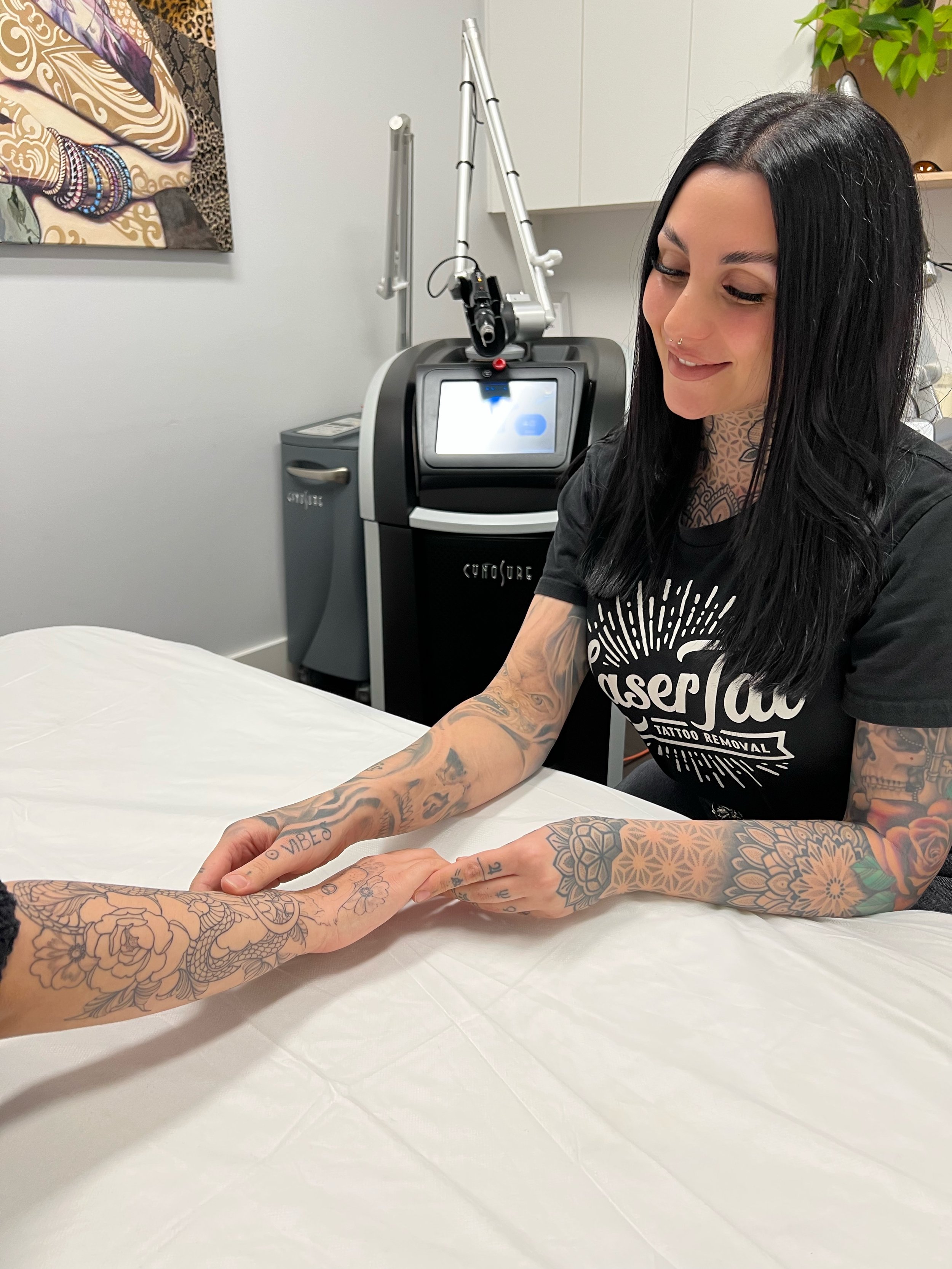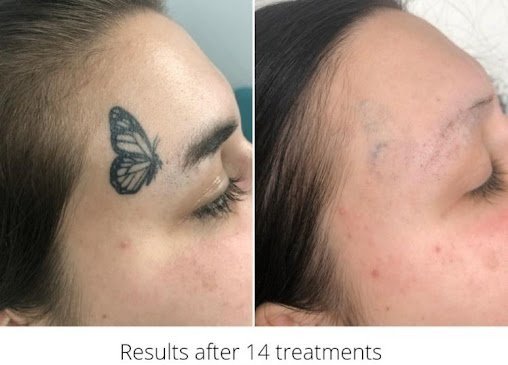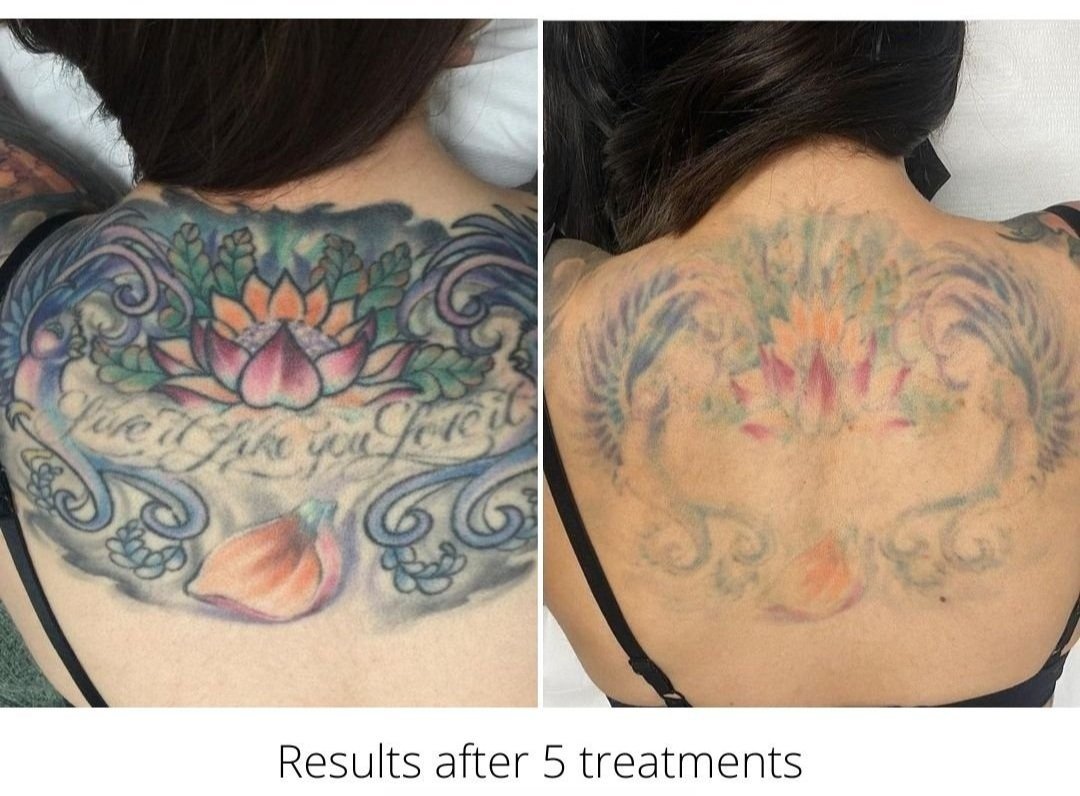There are several key factors that determine why some tattoos are easier to remove than others. We’ll narrow in on the most important ones in hopes to shed light on such a popular question.
Age of tattoo:
In terms of removal success, tattoos age just like a fine wine, the older the better!
It’s true, generally the older the tattoo the better it responds to laser. Tattoo ink is a foreign object in the body, therefore our immune system is always attacking the ink trying to get rid of it. This is the reason our tattoos fade over time, meaning the older the tattoo the less ink there is in the skin compared to a freshly done tattoo.
A freshly done tattoo will hold a lot of ink in the skin as the immune system has not yet gone to work to remove it over time.
Colour of tattoo:
Believe it or not, black ink is one of the easiest colours to remove. This is because black is an absorbing colour in comparison to white or yellow for example which is reflective. It is important that the ink absorbs the laser light to heat up the ink pigment to the point that it shatters, then allowing the body to remove those shattered particles through its lymphatic system.
Multi-colour tattoos require more than 1 wavelength to treat. Each wavelength of laser will target different colours and different depths of ink in the skin. This is the reason we have two lasers in our clinic (Picosure and Q-switch Revlite). This allows us to utilise 3 different wavelengths, 1064, 532 and 755 ultimately providing faster results for both black and colour ink particles.
White also plays a big part in pastel & cosmetic ink pigments. These colours are always more difficult to remove, often requiring more treatments as they can oxidise (meaning they go darker first).
Density of ink:
The more ink that’s in the skin, the more laser treatments the tattoo is going to need!
The deeper and darker the ink is, the further the laser has to penetrate to then be able to shatter it for your body to remove. This is why fine line and grey wash shading responds to laser at record speed. The density of ink is shallow and not as compact in comparison to a traditional and heavy line tattoo that lies deeper in the skin.
Size of the tattoo:
Just like the density, if we have a bigger tattoo there is obviously going to be more ink for the body to remove than a smaller tattoo.
Larger tattoos can often need more treatments as there is more ink particles to be processed by your immune system. On occasions we also need to split larger tattoos into separate treatments so we don’t overload the immune system. There’s a lot of work going on under the skin, don’t forget we need to allow your body time to not only remove the ink but also heal the area as well.
Location of tattoo:
Location, location, location!
Circulation is an important key factor when it comes to laser. A tattoo that is closest to our core, chest, neck and head have a better response rate to a laser treatment. Blood tends to flow slower the further away we get from the core and those areas. Therefore, lower legs, feet, fingers, etc. have a slower response rate to laser.
Immune system:
A strong and supported immune system is your greatest ally when it comes to laser tattoo removal. A laser machines job is to break the ink particles down as small and as effective as possible. The more active your immune system, the easier the shattered ink particles are going to be carried away. Eating well, sleeping well and not having laser treatments while your body is compromised by fatigue, injury or illness will help your body achieve its best results.
Drinking plenty of water, light active exercise and sleeping well can also contribute to a faster immune response to the laser. It almost goes without saying, the healthier you are, the quicker your body is going to remove the ink.
Type of ink:
A lot of people may not be aware but there are 100’s of different types of professional and amateur inks. We can’t always tell what brand or type of ink has been used in the tattoo and this can have a varied effect on how quickly it will respond.
Most standard tattoo ink colours are derived from heavy metals including carbon, titanium dioxide, iron oxide, lead, cobalt-nickel, chromium, and arsenic. Some of these metals are harder to break up with the laser than others and can require more treatments.
Time:
Patience is your best friend when it comes to tattoo removal. The LONGER you leave in between your laser appointments, the more results you will achieve. Your body will continue to process and remove the shattered ink particles for many weeks, months and even years.
While it’s not in everyone’s best interest to wait years between treatments, we can still maximise results leaving a few extra weeks between those treatments and allowing the body to remove more ink.
Quality of laser machine and operator:
This is such an important factor and one in which we invest heavily in! We have two of the BEST laser machines in the world so we can offer our clients the highest standard of laser technology possible. Our lasers from Cynosure are the Picosure and the Revlite C6. We use both Picosure and Q-switch technology to offer 3 wavelengths in order to maximise results and treat all colours.
Now the technology is all well and good, but we wouldn’t be where we are now without over 10 years experience in removing tattoos. Understanding what it takes to remove a tattoo as safely and as quickly as possible is not something you learn overnight. This takes experience, great understanding of skin, ink particles, different types of tattoos and how to use our technology to the best advantage for each individual tattoo.
Our approach has always been tailored to the individual as every tattoo is different and can respond differently based on all the above factors we have just mentioned. Once we assess the tattoo and individual we are able to come up with the most effective treatment plan in order to achieve fast and safe results.
We’ve broken down some of our before and after’s to demonstrate why these key factors are so important.
Greywash and location
Here is an amazing example why we emphasise on the location of where your tattoo is and why it plays such a large factor in the removal process. Paired up with the grey wash in this tattoo, we have a match made in heaven. Our client here also left many months between treatments allowing the tattoo to achieve maximum fading between treatments.
Older tattoo
It is commonly known that the older the tattoo, the easier it is to remove. With the tattoo ink being dormant in the client’s skin for decades and then being shattered by a laser treatment, it faded incredibly for our client to be able to receive this amazing cover-up
Colour and density of ink.
With this particular tattoo, the density of ink was close to the surface of the skin and majority of the tattoo was made up of grey wash/shading. Combining these two factors together resulted with complete removal in only 2 treatments for this client!
Location and newer tattoo
While this tattoo is only small, it is on the wrist area, freshly done and sitting fairly deep in the skin. The results have been a little slower in this area as it’s further away from the heart, meaning less blood flow.
Depth and density of ink
This tattoo is by no means a ‘fine line’ tattoo. There was a considerable amount of ink that needed to be broken down in order to achieve a complete removal
Density and scarring
Unfortunately being small in size doesn’t always mean easy removal.
This tattoo was done several times to the point of scar formation protruding from the skin. Scar tissue is thicker, making it harder for the laser to pass as effective as it sits above the ink in the tattoo.
Newer tattoo
We commenced laser treatments on this tattoo only months after it was first done. The newer the tattoo, the harder the body has to work to remove the ink, which is why this tattoo in particular took 14 treatments to achieve such results. This client also left over a year between her last treatments which allowed her body to continue to fade her tattoo.
Colour tattoos
Here is a prime example of how multiple wavelengths are required to treat different colours of ink within a tattoo. This client had a Picosure treatment which targets blue, purple, green and black. Red ink is treated on a completely different wavelength (532), which means it will require the use of both a Q-Switch and Picosure laser in order to target all the colours within this particular tattoo.
Want to know more?
Click HERE to book your consultation at our Port Adelaide or Munno Para clinic to discuss your treatment options today.









